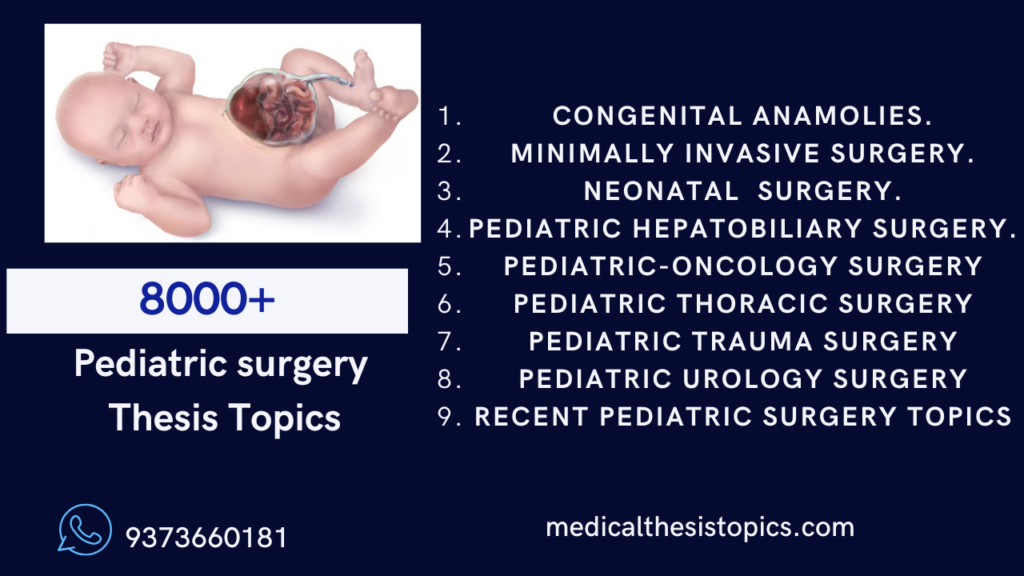PEDIATRIC SURGERY

Pediatric Surgery Thesis Topics for Mch/DNB Pediatric Surgery
Remember Subscribing to the premium Pediatric surgery thesis topics not only will enable you to browse through premium thesis topics but also you will get access to online guidance about synopsis writing, sample size calculation, inclusion and exclusion criteria and guidance throughout thesis writing. In case you dont subscribe still do not hesitate to contact me for guidance.
Below is the list of 100 free urology thesis topics for Mch/DNB Pediatric Surgery. You can select any good Pediatric Surgery thesis topics for Mch/DNB pediatric surgery from here. For more pediatric surgery thesis topics you can avail the service of premium pediatric surgery thesis topics. The premium pediatric surgery thesis topics include list of 8000+ Pediatric surgery thesis topics as well as recent topics which has been published in various national and international Pediatric surgery journals.
1. Comparative analysis of laparoscopic versus open pyeloplasty in managing ureteropelvic junction obstruction.
2. Long-term outcomes of robot-assisted partial nephrectomy versus laparoscopic nephrectomy in small renal masses.
3. The role of artificial intelligence in the diagnosis and management of bladder cancer.
4. Functional improvement in patients treated with sacral neuromodulation versus Botox injections for overactive bladder.
5. Outcomes of early versus delayed intervention in pediatric posterior urethral valves.
6. Long-term efficacy of potassium citrate versus thiazides in preventing calcium oxalate stone recurrence.
7. The role of genetic polymorphisms in predicting the risk of urolithiasis in Indian populations.
8. Comparative study of nephron-sparing techniques versus radical nephrectomy in traumatic renal injuries.
9. The effectiveness of targeted imaging in managing complex urological trauma.
10. Quality of life outcomes in pediatric patients undergoing staged versus single-stage hypospadias repair.
11. Long-term outcomes of immunosuppressive protocols in high-risk renal transplant recipients.
12. Functional improvement in patients with neurogenic bladder treated with clean intermittent catheterization versus indwelling catheterization.
13. Outcomes of early versus delayed repair in bladder trauma associated with pelvic fractures.
14. Role of preoperative imaging in determining surgical outcomes in patients with complex renal stones.
15. Long-term outcomes of metabolic evaluation in recurrent pediatric stone formers.
16. Comparative analysis of supine versus prone PCNL in managing staghorn calculi.
17. Efficacy of robotic-assisted ureteric reimplantation versus open surgery in pediatric vesicoureteral reflux.
18. The impact of diet and lifestyle modification on the recurrence of kidney stones in Indian patients.
19. Functional outcomes in patients undergoing dorsal versus ventral onlay urethroplasty for traumatic strictures.
20. Long-term renal function in patients treated with minimally invasive techniques versus nephrectomy for renal trauma.
21. The role of advanced imaging in early diagnosis of small renal masses.
22. Outcomes of retrograde intrarenal surgery versus shockwave lithotripsy in patients with solitary kidney stones.
23. Quality of life assessment in patients undergoing minimally invasive versus open pyeloplasty.
24. Comparative analysis of bladder cancer recurrence in patients treated with intravesical BCG versus mitomycin C.
25. Long-term renal function preservation in elderly patients treated with partial versus radical nephrectomy.
26. Functional improvement in patients treated with staged repair for complex posterior urethral injuries.
27. Outcomes of ureteroscopic lithotripsy versus PCNL in managing lower pole renal stones.
28. The impact of robotic technology on outcomes in reconstructive urology.
29. Long-term survival rates in renal transplant recipients undergoing early steroid minimization versus traditional protocols.
30. Role of advanced lithotripsy techniques in pediatric urolithiasis.
31. Comparative analysis of conservative management versus surgical intervention in high-grade renal trauma.
32. Long-term complications in patients undergoing augmentation cystoplasty for refractory neurogenic bladder.
33. Functional outcomes in pediatric patients undergoing primary repair versus staged reconstruction for hypospadias.
34. Outcomes of laser lithotripsy versus pneumatic lithotripsy in ureteric stones.
35. The effectiveness of metabolic evaluation in predicting recurrence rates in urolithiasis patients.
36. Quality of life assessment in elderly patients undergoing robotic-assisted nephrectomy versus laparoscopic nephrectomy.
37. Long-term outcomes of robotic-assisted versus open radical cystectomy in muscle-invasive bladder cancer.
38. Comparative analysis of outcomes in patients with bladder outlet obstruction treated with TURP versus laser vaporization.
39. Role of dietary sodium restriction in preventing recurrence of idiopathic calcium stones.
40. Long-term incidence of metabolic syndrome in patients with a history of renal transplant.
41. Functional improvement in patients undergoing minimally invasive versus open repair for ureteric strictures.
42. Outcomes of sacral neuromodulation in patients with chronic pelvic pain syndrome.
43. The role of AI-based tools in predicting the risk of urological malignancies.
44. Comparative study of stone clearance rates in micro-PCNL versus RIRS.
45. Long-term outcomes of surgical repair in patients with recurrent vesicoureteral reflux.
46. Outcomes of minimally invasive surgery versus open techniques in managing complex bladder trauma.
47. Functional improvement in patients undergoing endoscopic versus open surgical management of urethral diverticulum.
48. Quality of life assessment in patients undergoing minimally invasive management for overactive bladder.
49. Long-term recurrence rates in patients with bladder cancer treated with maintenance intravesical therapy.
50. The role of MRI in active surveillance of small renal masses.
51. Comparative analysis of outcomes in patients treated with early versus delayed intervention for obstructive uropathy.
52. Long-term efficacy of alpha-blockers versus combination therapy in managing benign prostatic hyperplasia.
53. Functional improvement in patients with recurrent urinary tract infections managed with immunotherapy.
54. Outcomes of partial versus complete cystectomy in patients with invasive bladder cancer.
55. Quality of life assessment in pediatric patients undergoing minimally invasive pyeloplasty.
56. Comparative study of outcomes in patients with malignant ureteric obstruction treated with metallic versus polymer stents.
57. Long-term outcomes of robotic-assisted versus open urethral reconstruction.
58. The role of thulium fiber laser in managing complex ureteric stones.
59. Functional improvement in patients undergoing balloon dilation versus stenting for ureteric strictures.
60. Outcomes of conservative management versus surgical intervention in non-urgent obstructive uropathy.
61. Quality of life outcomes in patients with neurogenic bladder undergoing sacral neuromodulation.
62. Long-term renal function in patients undergoing robotic-assisted versus laparoscopic nephroureterectomy.
63. Comparative analysis of outcomes in patients treated with intravesical gemcitabine versus BCG for bladder cancer.
64. Functional improvement in patients undergoing endoscopic versus open management of bladder neck contractures.
65. Outcomes of minimally invasive versus open surgery in patients with ureteropelvic junction obstruction.
66. Quality of life assessment in pediatric patients treated for complex urological anomalies.
67. Long-term outcomes of advanced imaging-guided PCNL versus traditional methods.
68. The role of real-time AI-guided imaging in managing complex renal stones.
69. Functional improvement in patients undergoing robotic-assisted ureteral reimplantation for vesicoureteral reflux.
70. Outcomes of endoscopic versus open repair in posterior urethral injuries.
71. Long-term recurrence rates in patients undergoing staged versus single-stage urethroplasty.
72. The role of gut microbiota modification in managing oxalate stones.
73. Functional outcomes in patients with urinary fistulas managed with robotic-assisted versus open repair.
74. Quality of life assessment in patients treated with advanced imaging-guided interventions for renal trauma.
75. Comparative analysis of ureteral stent versus nephrostomy in emergency obstructive uropathy.
76. Long-term outcomes of metabolic evaluation in pediatric patients with recurrent stone disease.
77. Functional improvement in patients undergoing robotic-assisted versus laparoscopic radical prostatectomy.
78. Outcomes of early versus delayed surgical intervention in malignant ureteric obstruction.
79. Quality of life outcomes in patients with benign prostatic obstruction treated with HoLEP versus TURP.
80. The impact of robotic-assisted techniques on outcomes in complex urethral reconstruction.
81. Long-term renal preservation in patients with solitary kidney undergoing partial nephrectomy.
82. Comparative analysis of surgical outcomes in robotic-assisted versus open radical cystectomy.
83. Functional improvement in pediatric patients undergoing staged versus single-stage reconstruction for bladder exstrophy.
84. Outcomes of advanced imaging technologies versus traditional techniques in managing urological trauma.
85. Long-term recurrence rates in patients treated with AI-assisted diagnosis and management for bladder cancer.
86. The role of diet and hydration counseling in preventing recurrence of uric acid stones.
87. Functional improvement in patients undergoing minimally invasive interventions for complex urological obstructions.
88. Outcomes of endoscopic realignment versus open surgical repair in posterior urethral trauma.
89. Quality of life assessment in patients undergoing robotic-assisted versus open surgical repair for urethral trauma.
90. Long-term complications in patients treated with nephrostomy versus stenting for infected hydronephrosis.
91. Functional improvement in patients with bladder neck obstruction managed with minimally invasive versus open techniques.
92. Outcomes of advanced imaging-guided PCNL in patients with multiple renal stones.
93. Quality of life outcomes in pediatric patients treated with early intervention for posterior urethral valves.
94. Comparative analysis of single-use versus reusable ureteroscopes in managing complex stones.
95. Long-term renal outcomes in patients undergoing robotic-assisted nephrectomy versus open nephrectomy.
96. Functional improvement in patients undergoing minimally invasive techniques for large renal stones.
97. Outcomes of metabolic evaluation in preventing recurrence of calcium phosphate stones.
98. Quality of life assessment in patients treated with real-time AI-guided interventions for bladder cancer.
99. Long-term outcomes of robotic-assisted versus laparoscopic ureteric reimplantation.
100.Functional improvement in patients undergoing ureteral stenting versus balloon dilation for malignant ureteric obstruction.












